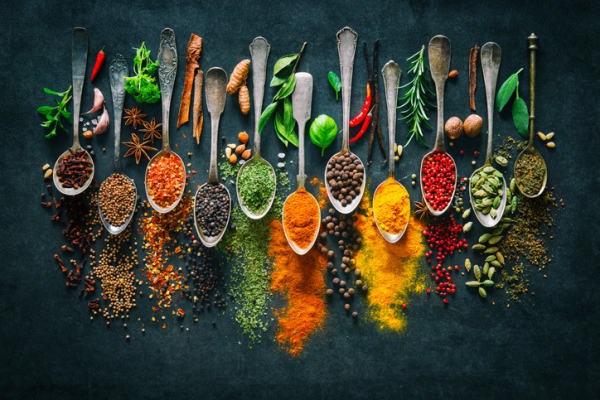
21 spices for healthy holiday foods

The holiday season is one of the hardest times of the year to resist salty, fatty, sugary foods. Who doesn’t want to enjoy the special dishes and treats that evoke memories and meaning — especially during the pandemic? Physical distancing and canceled gatherings may make you feel that indulging is a way to pull some joy out of the season.
But stay strong. While it’s okay to have an occasional bite or two of marbled roast beef, buttery mashed potatoes, or chocolate pie, gorging on them frequently can lead to weight gain, and increased blood pressure, blood sugar, and “bad” LDL cholesterol.
Instead, skip the butter, cream, sugar, and salt, and flavor your foods with herbs and spices.
The bounty of nature’s flavor-makers go beyond enticing tastes, scents, and colors. Many herbs and spices contain antioxidants, flavonoids, and other beneficial compounds that may help control blood sugar, mood, and inflammation.
Amp up holiday foods with herbs and spices
Try flavoring your foods with some of the herbs and spices in the list below. Play food chemist and experiment with combinations you haven’t tried before. The more herbs and spices you use, the greater the flavor and health rewards. And that’s a gift you can enjoy all year through.
Allspice: Use in breads, desserts, and cereals; pairs well with savory dishes, such as soups, sauces, grains, and vegetables.
Basil: Slice into salads, appetizers, and side dishes; enjoy in pesto over pasta and in sandwiches.
Cardamom: Good in breads and baked goods, and in Indian dishes, such as curry.
Cilantro: Use to season Mexican, Southwestern, Thai, and Indian foods.
Cinnamon: Stir into fruit compotes, baked desserts, and breads, as well as Middle Eastern savory dishes.
Clove: Good in baked goods and breads, but also pairs with vegetable and bean dishes.
Cumin: Accents Mexican, Indian, and Middle Eastern dishes, as well as stews and chili.
Dill weed: Include in potato dishes, salads, eggs, appetizers, and dips.
Garlic: Add to soups, pastas, marinades, dressings, grains, and vegetables.
Ginger: Great in Asian and Indian sauces, stews, and stir-fries, as well as beverages and baked goods.
Marjoram: Add to stews, soups, potatoes, beans, grains, salads, and sauces.
Mint: Flavors savory dishes, beverages, salads, marinades, and fruits.
Nutmeg: Stir into fruits, baked goods, and vegetable dishes.
Oregano: Delicious in Italian and Mediterranean dishes; it suits tomato, pasta, grain dishes, and salads.
Parsley: Enjoy in soups, pasta dishes, salads, and sauces.
Pepper (black, white, red): Seasons soups, stews, vegetable dishes, grains, pastas, beans, sauces, and salads.
Rosemary: Try it in vegetables, salads, vinaigrettes, and pasta dishes.
Sage: Enhances grains, breads, dressings, soups, and pastas.
Tarragon: Add to sauces, marinades, salads, and bean dishes.
Thyme: Excellent in soups, tomato dishes, salads, and vegetables.
Turmeric: Essential in Indian foods; pairs well with soups, beans, and vegetables.
About the Author

Heidi Godman, Executive Editor, Harvard Health Letter
Heidi Godman is the executive editor of the Harvard Health Letter. Before coming to the Health Letter, she was an award-winning television news anchor and medical reporter for 25 years. Heidi was named a journalism fellow … See Full Bio View all posts by Heidi Godman
About the Reviewer

Howard E. LeWine, MD, Chief Medical Editor, Harvard Health Publishing
Dr. Howard LeWine is a practicing internist at Brigham and Women’s Hospital in Boston, Chief Medical Editor at Harvard Health Publishing, and editor in chief of Harvard Men’s Health Watch. See Full Bio View all posts by Howard E. LeWine, MD

3 ways to create community and counter loneliness

Loneliness is complicated. You can feel lonely when you lack friends and miss companionship, or when you’re surrounded by people — even friends and family.
Either way, loneliness can have devastating health effects. It boosts risk for coronary artery disease, stroke, depression, high blood pressure, declining thinking skills, inability to perform daily living tasks, and even an early death. The remedy? Below we offer three ways to ease loneliness and add happiness by helping you expand your social network.
Taking the first steps
Not all loneliness can be solved by seeking out people. Loneliness that occurs despite relationships may require talk therapy and a journey that looks inward.
Reducing loneliness caused by a lack of relationships is more of an outward journey to make new friends. “That’s a challenge as we get older, because people are often established in their social groups and aren’t as available as they might have been in a different phase of life. So you have to be more entrepreneurial and work harder to make friends than you once did,” says Dr. Jacqueline Olds, a psychiatrist at Harvard-affiliated McLean Hospital and the coauthor of two books on loneliness.
Trying these strategies can help.
1. Seek like-minded souls
Being around people who share your interests gives you a head start on making friends: you already have something in common.
Start by considering your interests. Are you a voracious reader, a history lover, a movie aficionado, a gardener, a foodie, a puppy parent, or an athlete? Are you passionate about a cause, your community, or your heritage? Do you collect things? Do you love classic cars? Do you enjoy sprucing up old furniture? Maybe you want to learn something new, like how to cook Chinese food or speak another language. Search for online groups, in-person clubs, volunteer opportunities, or classes that match any of your interests or things you’d like to try.
Once you join a group, you’ll need to take part in it regularly to build bonds. If you can gather in person, it’s even better. “The part of our brain involved in social connection is stimulated by all five senses. When you’re with someone in the same room, you get a much stronger set of stimuli than you do by watching them on an electronic screen,” Dr. Olds says.
2. Create opportunities
If joining someone else’s group is unappealing, start your own. Host gatherings at your place or elsewhere. “All it takes is three people. You can say, ‘Let’s read books or talk about a TV show or have a dinner group on a regular basis,'” Dr. Olds says.
Other ideas for gatherings — either weekly or monthly — include:
- game nights
- trivia nights
- hikes in interesting parks
- beach walks
- bird-watching expeditions
- running or cycling
- meditation
- museum visits
- cooking
- knitting, sewing, or crafting
- shopping
- day trips to nearby towns
- jewelry making
- collector show-and-tell (comic books, antique dolls, baseball cards).
The people you invite don’t have to be dear friends; they can just be people you’d like to get to know better — perhaps neighbors or work acquaintances.
If they’re interested in a regular gathering, pin down dates and times. Otherwise, the idea might stay stuck in the talking stages. “Don’t be timid. Say, ‘Let’s get our calendars out and get this scheduled,'” Dr. Olds says.
3. Brush up your social skills
Sometimes we’re rusty in surface social graces that help build deeper connections. “It makes a huge difference when you can be enthusiastic rather than just sitting there and hoping someone will realize how interesting you are,” Dr. Olds says.
Tips to practice:
- Smile more. Smiling is welcoming, inviting, and hospitable to others.
- Be engaging. Prepare a few topics to talk about or questions to ask — perhaps about the news or the reason you’ve gathered (if it’s a seminar, for example, ask how long someone has been interested in the subject). Or look for a conversation starter. “Maybe the person is wearing a pretty brooch. Ask if there’s a story behind it,” Dr. Olds suggests.
- Be a good listener. “Listen in a way that someone realizes you’re paying attention. Hold their gaze, nod your head or say ‘Mm hmm’ as they’re talking so you give feedback. Assume everyone in the world is just yearning for your feedback,” Dr. Olds says.
- Ask follow-up questions. Don’t ignore signals that someone has interesting stories to tell. “If they allude to something, your job is to look fascinated and ask if they can tell you more. They’re dropping crumbs on a path to a deeper exchange,” Dr. Olds notes.
Even chats that don’t lead to friendships can be enriching. A 2022 study found that people who had the most diverse portfolios of social interactions — exchanges with strangers, acquaintances, friends, or family members — were much happier than those with the least diverse social portfolios.
Ultimately, a wide variety of interactions contributes to well-being, whether you’re talking to the cashier at the supermarket, a neighbor, an old friend, or a new one. And all of these connections combined may go a long way toward helping you feel less lonely.
About the Author

Heidi Godman, Executive Editor, Harvard Health Letter
Heidi Godman is the executive editor of the Harvard Health Letter. Before coming to the Health Letter, she was an award-winning television news anchor and medical reporter for 25 years. Heidi was named a journalism fellow … See Full Bio View all posts by Heidi Godman
About the Reviewer

Howard E. LeWine, MD, Chief Medical Editor, Harvard Health Publishing
Dr. Howard LeWine is a practicing internist at Brigham and Women’s Hospital in Boston, Chief Medical Editor at Harvard Health Publishing, and editor in chief of Harvard Men’s Health Watch. See Full Bio View all posts by Howard E. LeWine, MD